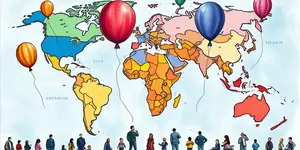
As global travel rebounds, nations that once thrived on visitor spending are confronting vulnerabilities. To ensure long-term stability and broad-based economic resilience, tourism-reliant regions must explore new pathways for growth.
Tourism accounts for an estimated 10% of global GDP in 2024, generating roughly US$10.9 trillion and supporting 357 million jobs worldwide. In nations like Turks and Caicos and the Maldives, tourism contributes more than half of all economic activity, while South Africa derives 3.7% of its GDP from this sector alone. Such figures underscore tourism’s capacity to drive infrastructure development and cultural preservation, attract foreign investment, and empower entrepreneurs.
Yet this reliance comes with acute sensitivity to global shocks. Pandemics, economic downturns, geopolitical tensions, and seasonal fluctuations can abruptly sever revenue streams, leaving jobs and public finances in jeopardy. Moreover, many tourism jobs are low-wage and less stable, intensifying social vulnerabilities when arrivals dip.
Overreliance on a single sector poses a stark threat to fiscal health. As tourism receipts falter, governments face unexpected budget shortfalls, compromising their ability to maintain essential services and invest in future growth. Diversification aims to fortify economies by broadening the base of revenue sources and smoothing out cyclical fluctuations.
From an economic theory perspective, nations tend to specialize at early stages of development before reaping the benefits of broader industry mixes as income grows. For small island states and developing countries, moving beyond a narrow tourism focus can foster job creation across multiple sectors and shield public coffers against external shocks.
Diversification unfolds on two complementary fronts: within the tourism sector itself and beyond it. By enhancing tourism offerings and building entirely new industries, governments can craft a more resilient economic landscape.
Beyond tourism, many economies are exploring:
Crucial to these initiatives are public-private partnerships and community involvement, ensuring that new ventures align with local strengths and social priorities.
Examining specific examples highlights both achievements and lessons learned. These cases illustrate how tailored strategies can yield diversified growth.
In Turks and Caicos, government-led incentives are attracting financial firms, while local operators develop eco-resorts and medical clinics. South Africa’s national plans champion wine tourism, cultural festivals, and farm-to-table agrotourism. Sierra Leone pairs heritage site preservation with agriculture, enhancing value chains from farm to guest table.
Despite clear benefits, obstacles remain. Institutional inertia, limited domestic markets, and skill gaps can hinder progress. To overcome these barriers, policymakers should consider the following:
As global dynamics evolve, tourism-dependent economies must embrace a dual mindset: celebrating the sector’s contributions while proactively building alternatives. Diversification does not diminish tourism’s value; instead, it infuses stability and creates new avenues for prosperity.
Future success will hinge on integrated planning, community empowerment, and strategic partnerships. By channeling tourism gains into broader economic development and fostering inclusive opportunities, nations can secure lasting fiscal health and social well-being.
Tourism will continue to enchant travelers and fuel local cultures. However, the lessons of recent crises reveal the necessity of robust economic safety nets. Through thoughtful diversification, countries can transform vulnerability into opportunity, ensuring that every beach, heritage site, and bustling market contributes to a resilient future.
References













